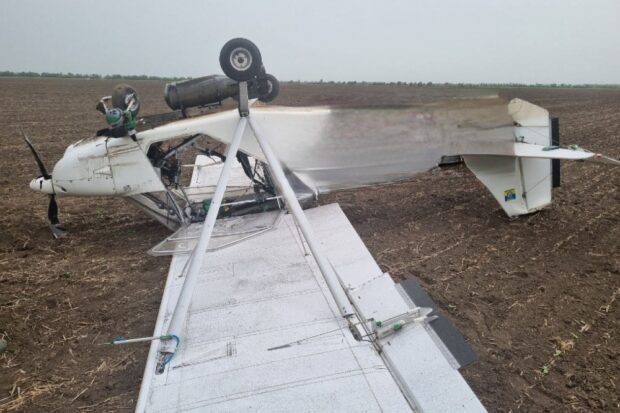Ukraine has transformed another sport plane into another long-range strike drone. One of them crashed inside Russia reportedly more than 600 miles from the Russia-Ukraine border, at least matching the depth of the first strike by an explosives-laden pilotless Ukrainian sport plane.
A photo circulated online by Russian propagandist Kirill Fedorov this week depicts the crashed do-it-yourself unmanned aerial vehicle upside down in a Russian field. The airframe is an adaptation of the Nynja, available pre-built from Aerosor in Kyiv, or as a kit the buyer assembles at home.
A Nynja ranges 400 miles at a cruise speed of around 100 miles per hour with a payload of several hundred pounds. “Good performance and pleasant handling,” was pilot Dan Johnson’s assessment of the type.
The Nynja is similar is shape, size and performance to Ukraine’s other drone sport plane, an adaptation of the locally made Aeroprakt A-22. On April 2, at least one unmanned A-22 packed with explosives rammed into the Alabuga Special Economic Zone industrial campus, 600 miles from the Ukrainian border, damaging part of a facility that produces Shahed drones for the Russian military.
The close look at the Nynja drone that Fedorov’s photos provide gives us a sense of how these DIY UAVs work. The wreck sports a turret for an electro-optical sensor—a video camera, basically—that might help a remote operator, connected to the drone via satellite, steer the drone into its target in the final seconds of flight.
Autonomous navigation over a potentially six-hour mission is probably GPS-assisted.
The wrecked Nynja packs a 220-pound FAB-100 bomb on an underbelly hard-point. Carrying its explosive payload under its belly rather than inside its cabin, like the A-22 apparently does, might imply the Nynja drone could drop its bomb and then turn around and return to base. That would make it reusable.
But there are reasons to be skeptical the Nynja drone’s designers meant for it to be multi-use. A Nynja ranges 400 miles on a 20-gallon tank, meaning it can fly 400 miles out and 400 miles back. But that Nynja drone in the photos crashed at least 600 miles from its base.
Unless there’s an extra fuel tank in the cabin—which, it’s worth noting, could weigh hundreds of pounds and eat into the payload—the Nynja drone that crashed in Russia was on a one-way trip that would’ve ended, one way or another, after around 800 miles.
Besides, it’s possible the Nynja drone costs just a few hundred thousand dollars once you add the sensors, communications, autopilot and explosive payload. It’s a steal compared to a multi-million-dollar cruise missile.
There isn’t really a compelling reason for Ukraine to use a Nynja drone more than once. Just send it on its way and strike something valuable: a Russian air base, factory or oil refinery. Even merely bothering Russian officials is worth the cost.
How many Nynja drones Ukraine might have on hand is hard to say. The various firms that have owned the basic design have contracted with the Ukrainian builder to produce at least 1,600 copies since 1991. That’s a lot of airframes.
Source: Forbes




